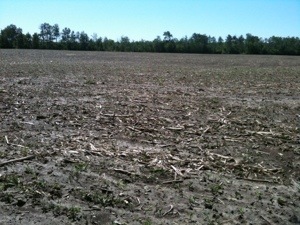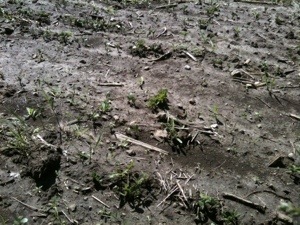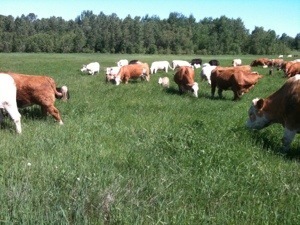Harry Stoddart's Blog, page 3
June 29, 2013
Some of Your Best Friends are “Germs”
Michael Pollan has a new article out on the microbiota that inhabit our bodies. I wish I had seen this before I completed my book – I could have expanded on several themes in a couple of chapters. It’s a long but fascinating discussion of the nascent study of the 90% of cells in our body that aren’t actually “our body”. They are cells of the organisms that live in and on “our body.” We are just beginning to understand why farm kids tend to be healthier than city kids. The link between breast milk and proper gut colonization. The link between the flora in a “Western gut” and diabetes. The list goes on. Here’s the link: http://www.nytimes.com/2013/05/19/magazine/say-hello-to-the-100-trillion-bacteria-that-make-up-your-microbiome.html?pagewanted=all&_r=1&.
And here’s one small excerpt:
The study of babies and their specialized diet has yielded key insights into how the colonization of the gut unfolds and why it matters so much to our health. One of the earliest clues to the complexity of the microbiome came from an unexpected corner: the effort to solve a mystery about milk. For years, nutrition scientists were confounded by the presence in human breast milk of certain complex carbohydrates, called oligosaccharides, which the human infant lacks the enzymes necessary to digest. Evolutionary theory argues that every component of mother’s milk should have some value to the developing baby or natural selection would have long ago discarded it as a waste of the mother’s precious resources.
It turns out the oligosaccharides are there to nourish not the baby but one particular gut bacterium called Bifidobacterium infantis, which is uniquely well-suited to break down and make use of the specific oligosaccharides present in mother’s milk. When all goes well, the bifidobacteria proliferate and dominate, helping to keep the infant healthy by crowding out less savory microbial characters before they can become established and, perhaps most important, by nurturing the integrity of the epithelium — the lining of the intestines, which plays a critical role in protecting us from infection and inflammation.
“Mother’s milk, being the only mammalian food shaped by natural selection, is the Rosetta stone for all food,” says Bruce German, a food scientist at the University of California, Davis, who researches milk. “And what it’s telling us is that when natural selection creates a food, it is concerned not just with feeding the child but the child’s gut bugs too.”
June 9, 2013
Interesting Animation of Water Cycle and Global Water Issues
This animation is beautiful and lays out the problems. Not much on solutions.
June 4, 2013
At the one third mark of the growing season
We’re two months into the growing season with less than 4 months until our usual frost date. I took the pictures in this post today. We’re a good way through our first rotation through all the paddocks. Our cows and sheep have been eating nothing but grass for 25 days. No diesel. No machines. The other two pictures are of the soybean field across the road. If you look closely, you can see the little beans poking up. This isn’t a late planted field. There are still hundreds of acres left to plant yet in our township.
Which field do you think has harvested more solar energy?
Which field has lost more soil to erosion?
Which field has more rain run off rather than soak in?
Which field has been sucking carbon out of the air and storing it in the soil?
May 22, 2013
Harry Stoddart: Renaissance Farmer
I did an interview with a local lifestyle magazine – Kawartha Life – a few months ago and completely forgot about it. Today I walked into my optometrist’s office (apparently grass-fed beef isn’t a miracle cure for the effects of aging on one’s eyes – I need reading glasses!) and the receptionist says, “you look a little different than in your picture.” She then handed me the new issue of Kawartha Life and there I was on the cover!
Here’s a link to the article: http://issuu.com/issuuprofi/docs/kl_may_2013_web/1

Harry on the cover of Kawartha Life magazine.
April 30, 2013
Spring on a Grass Fed Beef Farm
Ahh, spring. Once we get the mud over with, it’s my favourite time of the year. The dull greys and browns of winter are replaced with the vibrant greens of the countryside coming alive. Late April is a time of expectation: we’re anxiously awaiting the new growth in the pastures, the first cows are starting to bag up and getting ready to calve, the first litters of pigs are already running around and our first batch of chicks is almost feathered out.
Getting to Spring on a Grass fed Beef Farm
This year spring has a little more “expectation,” we’re trying to stretch our hay supply to last until the pastures are ready. Normally we put up more hay than we’ll need, just to be on the safe side. Last summer’s drought cut into our hay production and, even though we purchased some extra from a neighbour, we’ll need to be on the grass by the second week of May at the latest. This is one of the places where being 100% grass fed adds a challenge. We have more than enough home-grown grain for pig and chicken feed and could have easily stretched our hay by supplementing with some grain. Believe me, the temptation was there. I could have rationalized it by only feeding it to animals that wouldn’t be slaughtered before we were back on grass for at least a couple of months. It would have been easier to pull grain out of our bins than cash out of our wallets to purchase hay. But then I would have to explain why we needed to feed “a little” grain.
I like the simplicity of being able to say 100% grass fed, no grain – period. That’s the only definition accepted by the American Grass Fed Beef Association. If they certified farms in Canada, we would certify with them. I have my fingers crossed that they will eventually and therefore I meet their standards even though I don’t have to.
And so we eagerly await the new growth in the pasture. The cows eagerly await it too. They’re in a “sacrificial” pasture right now. Sacrificial because cattle hooves on the wet ground of April tears up a pasture pretty quickly. Despite all the pounding, there are some brave grass plants putting up green shoots and the cattle wander the pasture looking to get a small nip of a sweet treat. I can understand why. After four months of nothing but dry hay and water, a juicy, sweet grass shoot must be a delightful treat. When I let them on to the first pasture in a couple of weeks the cattle will go dancing and skipping across it looking for all the tastiest bits. And I will smile because feeding the cattle for the next 6 or 7 months won’t involve starting a tractor.
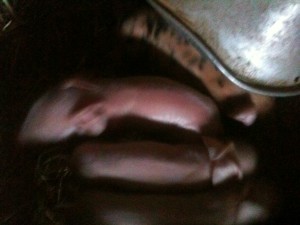
The first litter of 2013
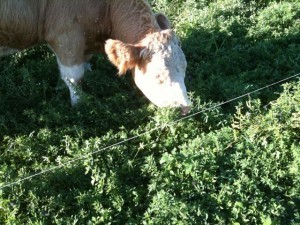
What grass fed cows dream about.
March 17, 2013
Where’s the real grassfed beef?
Grass-fed beef is slowly seeping into the consciousness of the general public. At the same time, “me too” pretenders are claiming their beef is grassfed. The American Grassfed Association (AGA) will only certify operations that use NO GRAIN whatsoever and only animals born and raised on a certified farm can be called certified grassfed. We meet the AGA standards for certification but unfortunately they only certify farms in the US.
The strict policy is easy to understand. If you look at the research, as soon as a beef animal starts eating grain, the fatty acid profile of the meat starts to change http://www.eatwild.com/healthbenefits.htm. Plus, it’s impossible to police “our animals are fed a little grain along with their hay.” Someone who feeds grain to cattle or sheep isn’t 100% committed to your health. Feeding grain is a shortcut to faster gains and an earlier finish (lower costs). Someone who feeds grain is not 100% committed to sustainable agriculture. A well managed perennial pasture builds soil, a grain field destroys soil. It’s that simple – there is no reason to destroy soil to produce lamb or beef (pork and chicken is a little more complicated but that’s a subject for another post).
So how can a consumer tell the difference? Sitting in a cooler there are no visual clues. However, asking the farmer or reading their website can be very informative. Many “grassfed” beef marketers openly admit to “feeding a little grain” and then go on to explain why they do. These are the easy ones to cross off your list. Others won’t mention the grain. The easiest way to sniff out the pretenders is to ask about their grazing program. Someone producing true grassfed beef will have an intensive rotational grazing system. They should be talking about moving their cattle to fresh pasture a minimum of every three days. It’s the only way to get enough energy into an animal to gain weight and put on some fat, we rarely leave cattle in the same paddock more than one day. Also ask them how many grazing days they get a year. In our part of the world, somewhere around 120 will be a “normal” answer which means they are likely feeding grain. People committed to management intensive grazing are always working to lengthen their grazing season. We have averaged a little over 200 grazing days for the last several years. None of these are fool proof but they should help you find the (real grassfed) beef!
A visit to the farm can also help. Take a walk with the farmer and see the cattle. But only do this once you think you’ve narrowed your choice down to one. Farmers are busy people and we need to make hay while the sun shines!
If you visit the farm and it looks something like this:
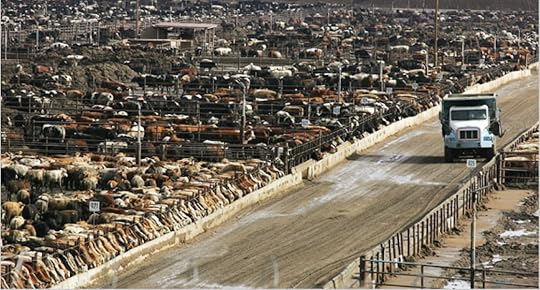
Not a grassfed farm!
You can be sure the beef isn’t grassfed!

